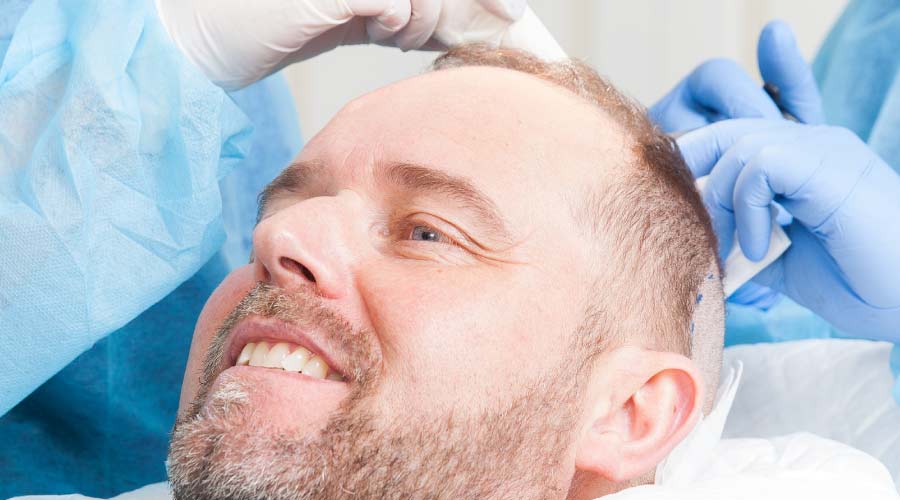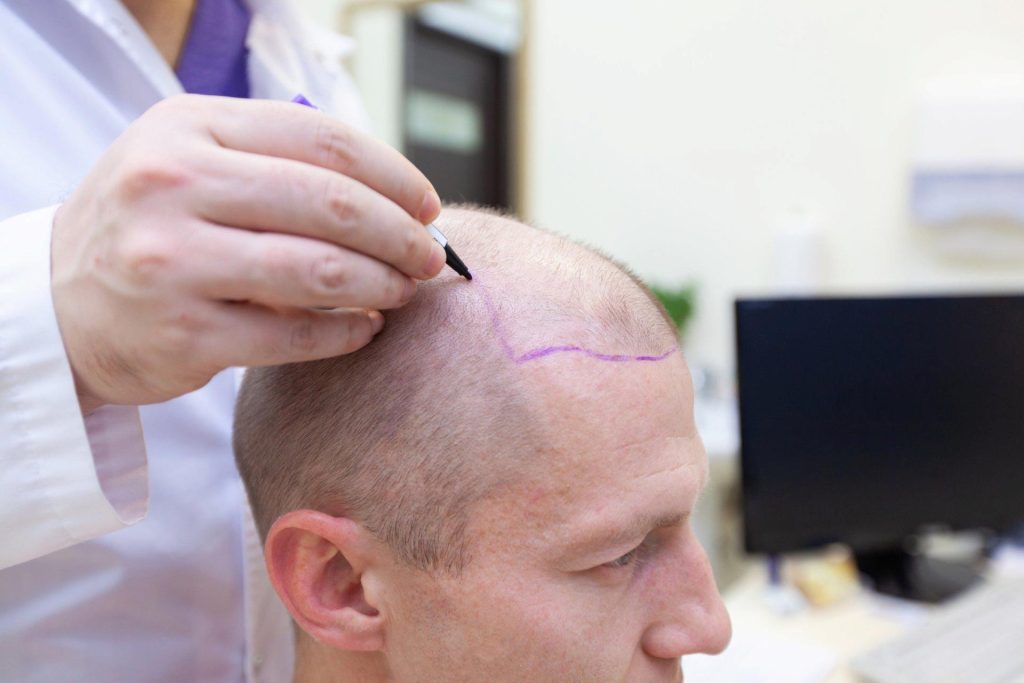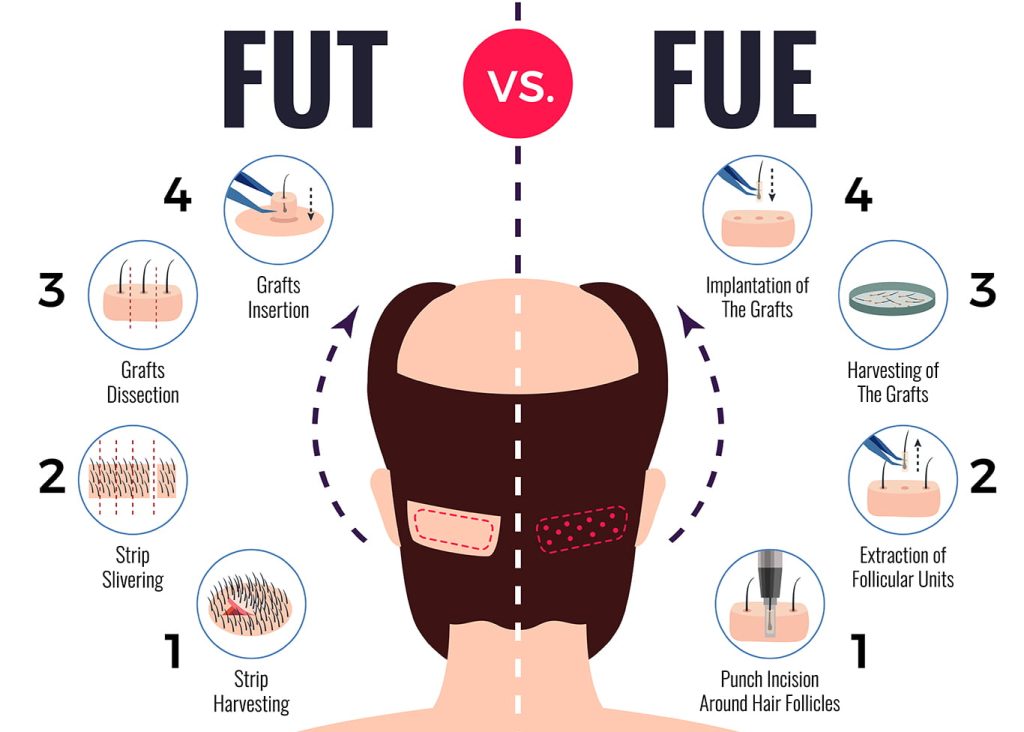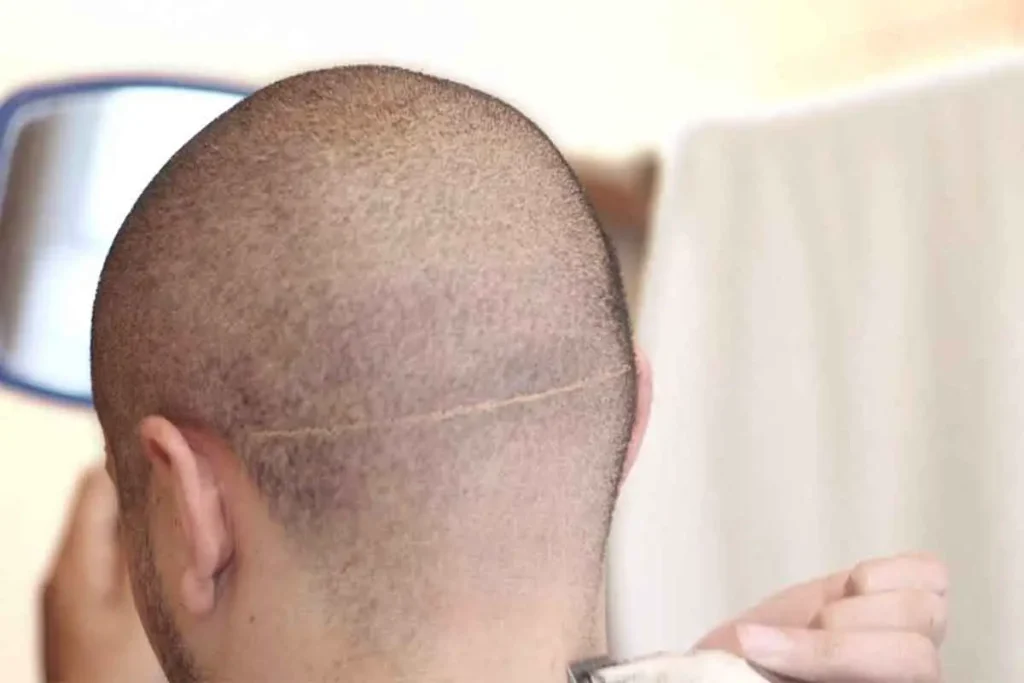Hair loss can be a significant concern for many, affecting self-esteem and one’s sense of identity. In the quest for a lasting solution, what is hair transplantation becomes a question on the minds of those seeking to regain a fuller head of hair. Hair transplantation is a surgical procedure that moves hair follicles from a part of the body, referred to as the ‘donor site’, to a bald or balding part of the body known as the ‘recipient site’. It’s primarily used to treat male pattern baldness, wherein the procedure grafts hair follicles that are genetically resistant to balding, thus promising a natural-looking hairline.
The process can vary in techniques, with some involving single strands of hair, while others move small groups of follicles. As one delves into the journey of hair restoration, understanding the procedure, its techniques, and expected outcomes is crucial for anyone considering this step.
What is Hair Transplant?

A hair transplant is a medical procedure used to address baldness and hair loss, which are common issues caused by factors such as genetics, age, hormonal imbalances, or certain medical conditions. This surgical technique involves the transplantation of hair follicles from one part of the body, known as the ‘donor site’, to a bald or balding part of the body referred to as the ‘recipient site’. The primary aim of a hair transplant is to restore hair growth in areas of the scalp that have little or no hair.
There are two main types of hair transplant procedures:
- Follicular Unit Transplantation (FUT): Also known as the strip method, this technique involves removing a strip of skin with hair follicles from the donor area (usually the back of the head), which is then divided into individual grafts and implanted into the balding areas.
- Follicular Unit Extraction (FUE): With this method, individual hair follicles are extracted directly from the donor area and then implanted one by one into the recipient site. This technique is less invasive than FUT and does not leave a linear scar.
During the procedure, the patient is typically under local anesthesia, and the surgery can take anywhere from a few hours to a full day, depending on the extent of the transplant. One of the primary benefits of a hair transplant is the longevity of the results; the transplanted hair generally continues to grow for a lifetime and is resistant to the factors that caused the original hair loss.
The success of a hair transplant depends on several factors including the skill of the surgeon, the quality of the donor hair, and the patient’s adherence to post-operative care instructions. Proper care will minimize the risks of complications and ensure optimal hair growth following the transplant.
While the thought of undergoing a hair transplant can be daunting, it is important to conduct thorough research and consult with a board-certified dermatologist or plastic surgeon who specializes in this field. It is also vital for candidates to have realistic expectations about the outcomes and to understand that it may take several months for the transplanted hair to grow in fully and blend seamlessly with the surrounding hair.
In summary, hair transplant is a permanent solution for those seeking to overcome hair loss and regain a fuller head of hair. Through innovative and evolving techniques, the procedure has become increasingly efficient and offers natural-looking results and improved self-esteem for many individuals.
Examining the Evolution of Hair Transplant Surgery
Hair transplant surgery has undergone significant evolution since its inception, allowing millions to regain not just their hair but their confidence too. From the early days of large grafts to the latest techniques in follicular unit extraction (FUE), the procedure has grown in sophistication and success. Let’s delve deeper into the milestones that have shaped the journey of hair transplantation.
The advent of hair transplants is often credited to Japanese surgeons in the 1930s and 1940s, who experimented with the transplantation of hair to reconstruct eyebrows and eyelashes for injury victims. It was, however, Dr. Norman Orentreich in New York City who, in the 1950s, first demonstrated that hair maintained its genetic resistance to balding even after being transplanted to a balding area, coining the term “donor dominance”. This pivotal discovery underpins all subsequent hair transplant procedures.
Early techniques involved the use of plug grafts, which involved removing large circular chunks of the donor scalp and inserting them into the balding area. While this was groundbreaking at the time, it was far from perfect—the plugs often looked unnatural and similar to a doll’s hair. In response to the demand for more refined results, mini-grafting and micro-grafting techniques were developed. These involved smaller grafts which allowed for a more natural hairline to be crafted.
The real game-changer came with the introduction of the FUE and strip harvesting, or follicular unit transplantation (FUT). FUT, introduced in the 1990s, involves removing a strip of skin with hair from the donor area, dissecting it under a microscope into individual follicular units, and transplanting these into the recipient area. While FUT can leave a linear scar, its efficiency in harvesting multiple grafts made it the gold standard for many years.
Meanwhile, FUE, which was refined in the 2000s, involves extracting individual hair follicles directly from the scalp without the need for a strip of tissue to be removed. This method reduces scarring and has become increasingly popular for those who want to wear their hair short or are concerned about the potential for a visible scar.
With advancements in technology, hair transplants are now more effective and natural-looking than ever. Robotic systems and precision tools have been designed to assist surgeons in performing transplants with greater speed and accuracy. Moreover, new techniques of preserving and implanting grafts, such as HypoThermosol and ACell therapy, have enhanced the success rates and the quality of hair growth.
To show a comparison between the old and new techniques, let’s present the data in a simple table:
| Year | Technique | Pros | Cons |
|---|---|---|---|
| 1950s-1970s | Plug grafts | Pioneering procedure | Unnatural results, visible scarring |
| 1980s-1990s | Mini/Micro grafting | More natural hairline | Still visible scarring |
| 1990s-2000s | FUT | Efficient, large number of grafts | Linear scarring |
| 2000s-Present | FUE | Minimizes scarring, precise | Time-consuming, technically demanding |
In conclusion, the evolution of hair transplant surgery has mirrored a consistent trend in medicine: the move toward techniques that produce more natural and satisfactory results for patients. With ongoing research and advancements, the future of hair restoration looks promising, with the potential for even less invasive procedures and improved outcomes. As we continue to refine these surgical methods, the line between natural hair and transplanted hair becomes increasingly indiscernible.
Pre-operative Considerations for Hair Transplant Candidates

Before undergoing a hair transplant, there are several key pre-operative considerations that candidates must be aware of to ensure the best possible outcomes. Hair transplants can be a significant change, not only aesthetically but also in terms of how candidates plan and prepare for the surgery. The following points highlight some of the crucial steps and precautions individuals should contemplate before the big day.
Firstly, it is essential to have realistic expectations. Although hair transplantation can produce remarkable results, it is not a cure-all solution for baldness. Results can vary based on the individual’s hair type, density, and the nature of their hair loss. Consulting with a qualified surgeon who can assess scalp health and hair loss pattern is integral; they can help set realistic expectations and determine if you are a good candidate for the procedure.
Secondly, candidates should be in good overall health. Underlying medical conditions can affect the healing process and the success of the transplant. It is vital to disclose any medical history or medications to the surgeon during the initial consultations. Blood thinners, for instance, may need to be paused as they can increase the risk of bleeding during the operation. Always follow the medical advice provided by your healthcare provider.
Thirdly, it is recommended to avoid alcohol and smoking several days before the surgery. These substances can impair blood flow and interfere with the healing process, potentially affecting the final outcome of the hair transplant. Ensuring proper pre-operative care by avoiding such substances will help optimize the body’s condition for the surgery and post-operative recovery.
Moreover, adequate scalp care is imperative before the operation. The surgeon may advise against cutting your hair before the procedure, as longer hairs might help in hiding the post-surgery scars. Additionally, they may recommend special shampoos or topical treatments to ensure the scalp is in the best condition for the transplant.
Lastly, arranging for downtime and assistance post-surgery is wise. You will need time to recover, and straining yourself could be detrimental to the healing process. Having someone to help around the house, especially in the first few days following surgery, can be incredibly beneficial. It’s also important to follow the post-operative care plan provided by your hair restoration clinic closely to ensure the best possible outcome.
By considering these pre-operative steps, hair transplant candidates can feel prepared and at ease knowing that they have taken the necessary precautions to maximize safety and success. Remember, thorough communication with your hair restoration specialist is key throughout the entire process.
Step-by-Step Guide to the Hair Transplant Procedure
Undergoing a hair transplant can be a significant decision for many, often offering a permanent solution to hair loss. Here’s a detailed guide to what to expect during a hair transplant procedure, broken down into a step-by-step process.
Initial Consultation
The first step in the journey of hair restoration is an initial consultation. During this meeting, you’ll discuss your hair loss concerns with a qualified professional, who will assess your scalp and hair, evaluate your medical history, and discuss your expectations. This session will determine whether you’re an ideal candidate for a hair transplant and what technique is appropriate for you.
Pre-Procedure Preparation
Once you have been deemed suitable for the procedure, the clinic may give you special instructions to follow. This often includes avoiding certain medications that might increase bleeding, abstaining from smoking, and not consuming alcohol for a set period before the procedure.
The Hair Transplant Procedure
- Harvesting the Donor Hair: This step involves the removal of hair follicles from the donor area, usually the back of the head, which is resistant to balding. There are two primary techniques:
- Follicular Unit Transplantation (FUT): A strip of scalp is removed and then dissected into individual grafts.
- Follicular Unit Extraction (FUE): Individual hair follicles are directly extracted from the scalp.
- Preparation of the Grafts: The harvested hair follicles are carefully prepared under a microscope to get them ready for transplantation. During this time, they are kept in a special solution to maintain viability.
- Creating the Recipient Sites: The surgeon creates tiny incisions in the recipient area of the scalp where hair loss has occurred, taking care to establish the right angle, depth, and direction for natural-looking results.
- Placement of Hair Grafts: The final step in the procedure is carefully placing the individual hair grafts into the prepared sites. This step requires a high level of precision to ensure the best possible cosmetic outcome.
Post-Procedure Care
The success of a hair transplant doesn’t just rely on the surgery itself but also on proper post-procedure care. After the surgery, your scalp may be tender, and you may need to take medications for pain and to prevent infection and swelling. Here’s what typical post-operative care might involve:
- Taking prescribed antibiotics to prevent infections.
- Using anti-inflammatory medications to keep swelling at bay.
- Avoiding vigorous physical activity for a few weeks to ensure proper healing.
- Following the surgeon’s instructions on how to wash your hair without disturbing the graft sites.
Recovery and Results
Hair transplant recovery can vary from patient to patient, but it’s common to experience some shedding of the transplanted hair—this is a normal part of the process. New growth typically begins a few months after the procedure. Within six to nine months, most patients can see a significant improvement in hair density. The final results of the transplant can be evaluated after a full year.
By understanding these steps, you can set realistic expectations and prepare yourself for a hair transplant. Remember to research qualified professionals and choose a reputable clinic to ensure the best outcome for your hair restoration journey.
FUT versus FUE: Comparing Hair Transplant Methods

When considering a hair transplant, understanding the different techniques available is essential for making an informed decision. The two most common methods are Follicular Unit Transplantation (FUT) and Follicular Unit Extraction (FUE). Both have their unique advantages and limitations, and here we will delve into the specifics of each to help you discern which might be the best fit for your needs.
FUT, also known as strip harvesting, is an older method of hair transplantation. During FUT, a surgeon removes a strip of skin from the donor area, usually the back of the head where hair is more resistant to balding. The donor strip is then dissected into individual follicular units under a microscope, and these units are transplanted into the balding areas.
One significant advantage of FUT is that it typically allows for a greater number of grafts to be transplanted in a single session, making it ideal for patients with significant hair loss. However, FUT typically leaves a linear scar in the donor area, which may be visible with certain hairstyles. It also involves a longer healing time and more discomfort post-surgery.
FUE, on the other hand, is a newer technique that involves extracting individual hair follicles directly from the scalp rather than removing a strip of tissue. Surgeons use a small punch tool to remove the follicles one by one. This method leaves no linear scar, allowing patients to sport short hairstyles without visible scarring. FUE is less invasive, typically involves less pain during recovery, and has a quicker healing process. However, it is often more time-consuming and may require multiple sessions to achieve the desired results. Additionally, FUE can be more expensive than FUT due to the labor-intensive nature of the technique.
Both hair transplant methods have strong success rates, and the final outcome often depends on factors such as the skill of the surgeon, the quality of the donor hair, and the patient’s adherence to postoperative care. When deciding between FUT and FUE, consider factors like the extent of your hair loss, your lifestyle, and long-term hair restoration goals. It is also crucial to consult with a reputable hair transplant surgeon who can provide personalized advice based on your specific situation.
In summary, both FUT and FUE are capable of producing natural-looking and long-lasting results. FUT may be more suitable for those with extensive hair loss who don’t mind the potential for linear scarring. Conversely, FUE might appeal to those who prefer a less invasive procedure with minimal scarring and a faster recovery, albeit at a potentially higher cost and with the possibility of requiring more than one session. Carefully weigh the pros and cons of each method in consultation with your surgeon to make the best decision for your hair restoration journey.
Postoperative Care and Expectations in Hair Transplantation
After undergoing a hair transplant procedure, it’s critical that patients have a clear understanding of postoperative care to ensure the best possible outcomes. Hair transplant surgery – while minimally invasive – still requires a dedicated regimen during the recovery phase to promote proper healing and hair growth. Below you will find detailed guidance to assist you on your journey to a fuller head of hair.
Detailed Postoperative Care Instructions
The first 48 hours after your hair transplant are vital. Avoid washing your scalp or participating in any strenuous activity. You may experience some swelling and discomfort which can be managed with prescribed medication. Follow your surgeon’s instructions closely, as they will provide tailored advice for your specific needs.
From day 3, you can begin to gently wash your hair with a mild shampoo. It’s important to be very gentle to not disrupt the new grafts. Pat your scalp dry with a soft towel—never rub.
You should expect some scabbing around the transplanted follicles; this is normal and part of the healing process. Scabs usually clear within 7-14 days. Any persistent redness or irritation should be reported to your surgeon immediately.
Activities to Avoid
For at least a week post-surgery, avoid any activities that could increase blood flow to the scalp such as bending over, picking up heavy objects, or exercising. This precaution reduces the risk of bleeding and swelling. Additionally, it’s advised to avoid alcohol and smoking for at least the first month post-transplant as they can impede healing and affect hair growth.
Expectations for Hair Growth
Initial hair growth can be seen as early as two to three months post-surgery but remember, patience is key. The final results of your transplant may not be visible until the one-year mark. Most patients see significant improvement by the sixth month, with continued growth and density over time.
A common concern is “shock loss,” which is a temporary thinning of the pre-existing hair due to the trauma of surgery. This is normal and usually resolves itself within a few months.
| Timeframe | Postoperative Milestones |
|---|---|
| First 48 Hours | Rest and avoid touching the grafts |
| Day 3-14 | Gentle washing begins, scabbing, and healing |
| 1 Month | Avoid alcohol and smoking, increase activity gradually |
| 2-3 Months | Initial hair growth |
| 6 Months | Significant improvement in hair density |
| 1 Year | Final results |
“Your newly transplanted hair is an investment in your appearance. Remember, the best results come from following your postoperative regimen with patience and diligence.”
It’s essential to keep a good line of communication with your hair transplant team. They can address any concerns you may have and guide you on how to best care for your transplanted hair. Trust the process, and look forward to the gradual emergence of your new hairline and the confidence that comes with it.
Minimizing Risks: Ensuring Safety During Hair Transplantation

Hair transplantation is a significant cosmetic procedure that can enhance self-esteem and confidence. However, as with any surgical intervention, it comes with its set of risks and complications. To ensure patient safety and maximize the successful outcome of the procedure, it is crucial to follow certain precautionary measures. Here, we delve into the vital steps that should be taken to minimize risks during hair transplantation.
- Choosing a Qualified Surgeon: The expertise of the surgeon is paramount.
Ensure that the surgeon is certified by a recognized medical board and has ample experience performing hair transplants. A reputable surgeon will minimize the risk of complications and ensure the most aesthetically pleasing results.
- Conducting a Thorough Pre-Operative Assessment: A detailed medical evaluation is critical.
The surgeon should conduct a comprehensive examination to assess your hair loss pattern, scalp elasticity, and other factors that could influence the surgery’s outcome. This assessment also helps to detect any underlying conditions that might complicate the procedure.
- Maintaining a Sterile Environment: Infection control is essential.
The facility should adhere to strict sterilization protocols. All equipment and operating areas must be sterilized to prevent infections. A clean environment reduces the risk of complications and promotes better healing.
- Understanding Individual Risk Factors: Each patient is unique.
Prior medical history, including medication use, allergies, and lifestyle habits like smoking or alcohol consumption, can affect the surgery’s outcome. The surgeon should be fully aware of these factors to tailor the procedure accordingly.
- Utilizing Advanced Technologies: Modern techniques reduce risks.
Innovative methods like FUE (Follicular Unit Extraction) or robotic hair transplantation offer precision and reduced trauma to the scalp. These techniques can lead to faster recovery and lesser chances of scarring.
- Following Proper Aftercare Procedures: Post-operative care is vital.
Adhering to the surgeon’s aftercare instructions can significantly impact the healing process and the ultimate success of the transplant. This includes proper wound care, medication routines, and avoiding activities that might stress the scalp.
- Monitoring for Post-Operative Complications: Stay vigilant after the surgery.
Any signs of infection, excessive bleeding, or unusual discomfort should be reported to the surgeon immediately. Early detection of complications can prevent them from escalating and can be dealt with promptly.
Ensuring safety during hair transplantation is not solely the responsibility of the medical team but also of the patients. Being well-informed, selecting the right professionals, and adhering to the given instructions are all crucial steps in minimizing risks and guaranteeing a positive outcome. Remember, the goal is not just to achieve a fuller head of hair but to do so in the safest manner possible.
Frequently Asked Questions
What is a hair transplant?
A hair transplant is a surgical procedure that involves moving hair follicles from one part of the body, known as the donor site, to a bald or balding part of the body known as the recipient site.
Who is a good candidate for a hair transplant?
Good candidates for a hair transplant are individuals with sufficient donor hair and realistic expectations. People with pattern baldness, thinning hair, or those who have lost hair due to injury are typically suitable.
How long does a hair transplant procedure take?
A hair transplant procedure can take anywhere from 4 to 8 hours depending on the extent of the transplant.
Is a hair transplant painful?
Patients are usually given local anesthesia before the procedure, so there should be minimal pain during the surgery. Some discomfort, swelling, and tenderness can be expected during recovery.
What is the difference between FUT and FUE hair transplants?
FUT (Follicular Unit Transplantation) involves removing a strip of skin with hair follicles from the donor area, while FUE (Follicular Unit Extraction) involves extracting individual hair follicles directly from the scalp.
How much does a hair transplant cost?
The cost of a hair transplant varies depending on the extent of the procedure and the technique used. It can range from several thousand to tens of thousands of dollars.
What is the success rate of hair transplants?
Hair transplants generally have a high success rate, with many patients experiencing significant hair growth after one year. However, individual results may vary.
How long does it take to recover from a hair transplant?
Recovery time varies, but most patients can return to work within 2 to 5 days after the procedure. Full healing and hair growth may take several months to a year.
Are there any risks associated with hair transplants?
As with any surgical procedure, there are risks such as infection, bleeding, scarring, and unnatural-looking hair growth. Choosing an experienced surgeon can reduce these risks.
Can women undergo hair transplants?
Yes, women can also undergo hair transplants, particularly if they are experiencing pattern baldness or thinning hair.
